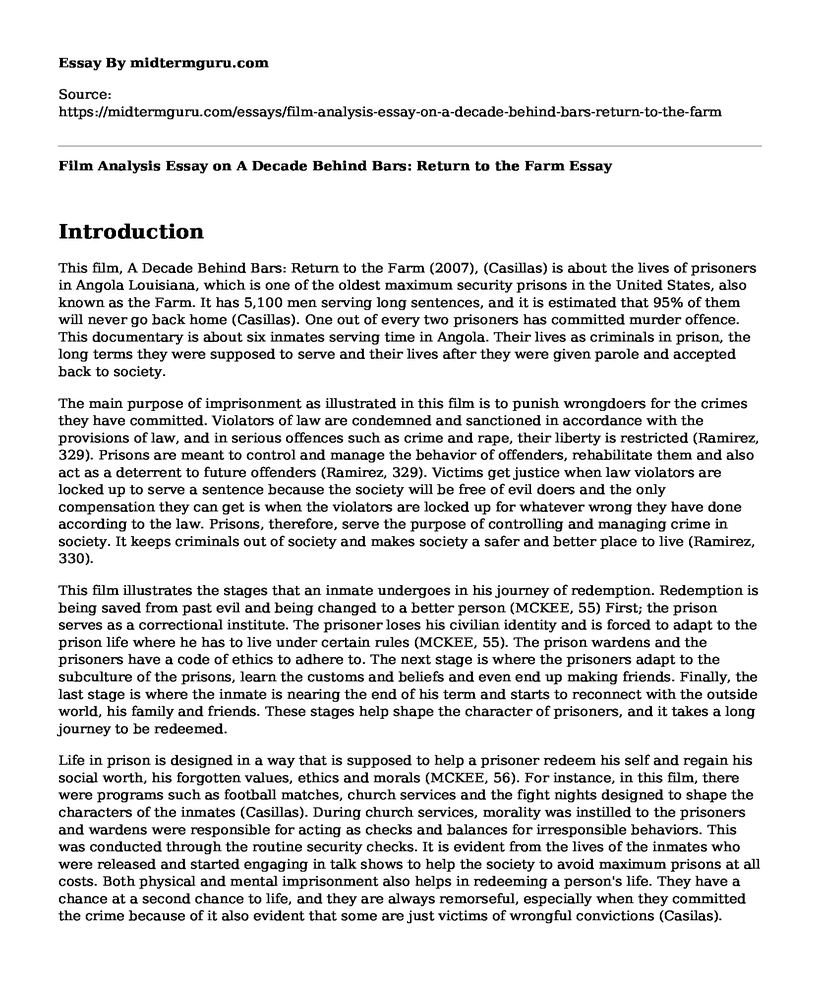Introduction
This film, A Decade Behind Bars: Return to the Farm (2007), (Casillas) is about the lives of prisoners in Angola Louisiana, which is one of the oldest maximum security prisons in the United States, also known as the Farm. It has 5,100 men serving long sentences, and it is estimated that 95% of them will never go back home (Casillas). One out of every two prisoners has committed murder offence. This documentary is about six inmates serving time in Angola. Their lives as criminals in prison, the long terms they were supposed to serve and their lives after they were given parole and accepted back to society.
The main purpose of imprisonment as illustrated in this film is to punish wrongdoers for the crimes they have committed. Violators of law are condemned and sanctioned in accordance with the provisions of law, and in serious offences such as crime and rape, their liberty is restricted (Ramirez, 329). Prisons are meant to control and manage the behavior of offenders, rehabilitate them and also act as a deterrent to future offenders (Ramirez, 329). Victims get justice when law violators are locked up to serve a sentence because the society will be free of evil doers and the only compensation they can get is when the violators are locked up for whatever wrong they have done according to the law. Prisons, therefore, serve the purpose of controlling and managing crime in society. It keeps criminals out of society and makes society a safer and better place to live (Ramirez, 330).
This film illustrates the stages that an inmate undergoes in his journey of redemption. Redemption is being saved from past evil and being changed to a better person (MCKEE, 55) First; the prison serves as a correctional institute. The prisoner loses his civilian identity and is forced to adapt to the prison life where he has to live under certain rules (MCKEE, 55). The prison wardens and the prisoners have a code of ethics to adhere to. The next stage is where the prisoners adapt to the subculture of the prisons, learn the customs and beliefs and even end up making friends. Finally, the last stage is where the inmate is nearing the end of his term and starts to reconnect with the outside world, his family and friends. These stages help shape the character of prisoners, and it takes a long journey to be redeemed.
Life in prison is designed in a way that is supposed to help a prisoner redeem his self and regain his social worth, his forgotten values, ethics and morals (MCKEE, 56). For instance, in this film, there were programs such as football matches, church services and the fight nights designed to shape the characters of the inmates (Casillas). During church services, morality was instilled to the prisoners and wardens were responsible for acting as checks and balances for irresponsible behaviors. This was conducted through the routine security checks. It is evident from the lives of the inmates who were released and started engaging in talk shows to help the society to avoid maximum prisons at all costs. Both physical and mental imprisonment also helps in redeeming a person's life. They have a chance at a second chance to life, and they are always remorseful, especially when they committed the crime because of it also evident that some are just victims of wrongful convictions (Casilas).
Conclusion
Prisons have both good and bad effects on the social fabric. Some of the effects prisons have on the family are; many marriages are broken, and if not, it is very hard to manage one. The family members lose respect in the society when one of the family members is imprisoned. The financial burden prisons impose on a family when the bread winner is imprisoned hard to endure, let alone the effects it has on children such as depression and having to live without a parent. The society is also affected at large because the family stigma will be projected to the society. When a prisoner is out after serving a term, the community will live in fear because they were once victims and it is hard to tell whether one has changed or not. However, some of the prisoners come out changed men and bring change to society.
Works Cited
Casillas, John. "A Decade Behind Bars: Return To The Farm ( 2007 )". Youtube, 2016, https://www.youtube.com/watch?v=lPsJJSShi5E. Accessed 8 Nov 2018.
MCKEE, TAMARV S. "The cost of a second chance: life, death, and redemption among prison inmates and Thoroughbred ex-racehorses in Bluegrass Kentucky." Economies of Death. Routledge, 2015. 55-72.
Ramirez, Mark D. "Punitive sentiment." Criminology 51.2 (2013): 329-364.
Cite this page
Film Analysis Essay on A Decade Behind Bars: Return to the Farm. (2022, Sep 28). Retrieved from https://midtermguru.com/essays/film-analysis-essay-on-a-decade-behind-bars-return-to-the-farm
If you are the original author of this essay and no longer wish to have it published on the midtermguru.com website, please click below to request its removal:
- Directing Manifesto - Essay Example
- Art Essay Sample: Migrant Mother - Photograph by Dorothea Lange
- Films Analysis Essay on Tapped and Affluenza
- Film Analysis Essay on Suicide Squad
- How Smartphones Affect Real Life Communication: Research Paper
- Movie Analysis Essay on The Wizard of Oz
- Capture Change: Exploring the Image of Real-World Photographers - Essay Sample







